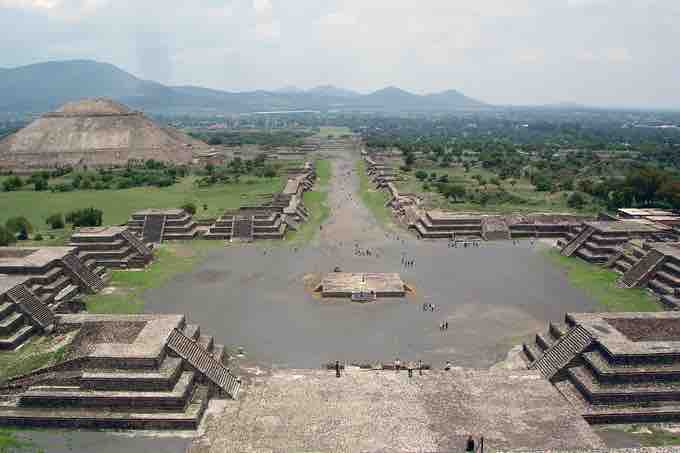Teotihuacan
Located some 30 miles northeast of present-day Mexico City, Teotihuacan experienced a period of rapid growth early in the first millennium CE. By 200 CE, it had emerged as a significant center of commerce and manufacturing, the first large city-state in the Americas. At its height, between 350 and 650 CE, Teotihuacan covered nearly 9 miles and had a population of about 200,000, making it one of the largest cities in the world at that time. One reason for its dominance was its control of the market for high-quality obsidian. This volcanic stone, made into tools and vessels, was traded for luxury items such as the green feathers of the quetzal bird, used for priestly headdresses, and the spotted fur of the jaguar, used for ceremonial garments.

Ceremonial center of the city of Teotihuacan, Mexico, Teotihuacan culture, c. 350-650 CE.
View from the Pyramid of the Moon down the Avenue of the Dead to the Ciudadela and the Temple of the Feathered Serpent. The Pyramid of the Sun is at the middle left. The avenue is over a mile long.
The people of Teotihuacan worshipped many deities that were recognizably similar to those worshipped by later Mesoamerican people, including the Aztecs, who dominated central Mexico at the time of the Spanish Conquest. Among these are the Rain or Storm God (god of fertility, war, and sacrifice), known to the Aztecs as Tlaloc, and the Feathered Serpent, known to the Maya as Kukulcan and to the Aztecs as Quetzalcoatl.
Teotihuacan's principal monuments include the Pyramid of the Sun, the Pyramid of the Moon, and the Ciudadela (Spanish for fortified city center), a vast sunken plaza surrounded by temple platforms. The city's principal religious and political center, the Ciudadela could accommodate an assembly of more than 60,000 people. Its focal point was the pyramidal Temple of the Feathered Serpent. This seven-tiered structure exhibits the taludtablero construction that is a hallmark of the Teotihuacan architectural style. The sloping base, or talud, of each platform supports a vertical tablero, or entablature, which is surrounded by frame and filled with sculptural decoration. The Temple of the Feathered Serpent was enlarged several times, and - as was characteristic of Mesoamerican pyramids - each enlargement completely enclosed the previous structure, like the layers of an onion. Archaeological excavation of this temple's earlier-phase tableros and a stairway balustrade have revealed painted heads of the Feathered Serpent, the goggle-eyed Rain or Storm God, and reliefs of aquatic shells and snails. The flat, angular, abstract style, typical of Teotihuacan art, is in marked contrast to the curvilinear style of Olmec art.
Temple of the Feathered Serpent, the Ciudadela.
Detail of pyramid, showing the alternating talud base and vertical tablero (left).
The Decline
Sometime in the middle of the seventh century disaster struck Teotihuacan. The ceremonial center burned, and the city went into a permanent decline. Nevertheless, its influence continued as other centers throughout Mesoamerica and as far south as the highlands of Guatemala borrowed and transformed its imagery over the next several centuries. The site was never entirely abandoned, however, because it remained a legendary pilgrimage center. The much later Aztec people (c. 1300-1525 CE) revered the site, believing it to be the place where the gods created the son and the moon. In fact, the name "Teotihuacan" is actually an Aztec word meaning "Gathering Place of the Gods."